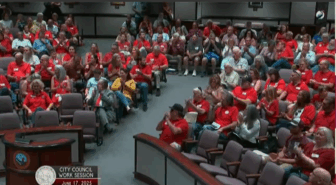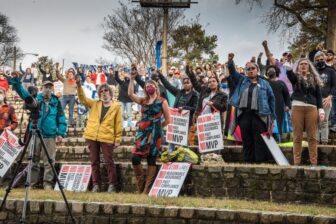-Written by Helena Schmitt
During my freshman year writing class at the George Washington University this past spring, I wrote a research paper about the “Fridays for Future” climate change movement led by teenage Swedish activist Greta Thunberg.
This week, I met Greta face to face.
This month was historic for climate activism. Greta has inspired millions of people around the world since she started skipping school to go on a “climate strike” every Friday for over a year. As her movement gained traction, she became the central image for the climate change movement and gave speeches to government officials more than twice her age at events such as the COP 24, World Economic Forum, and the EU Parliament. Then she finally crossed the Atlantic towards New York City on a sailboat, the only carbon-free solution she could find. Her first arrival in North America since beginning the movement has led to a crazy few weeks for climate activists — not only in DC, but also in America and the world as a whole. I was fortunate enough to see her twice.
Striking in Front of the White House with Greta Thunberg
It was announced on Wednesday, September 11, that Greta would carry out her 56th strike on September 13 in outside of the White House — only two days later. I arrived very early; I was excited to interact and strike with a woman I had been admiring for a long time. At first, it was just myself and the organizers in attendance, and I watched the crowd surge in size and anticipation while waiting for Greta to arrive. The crowd at this strike was young — it looked like a lot of kids actually skipped school to come. A few hundred people ended up striking with merely two days notice, and lead strikers noted that they were used to only having around 20 people join them in the typical Friday strike.
Besides the over-eager press corps looking to catch a glimpse of Greta in action, this strike felt authentic, like it accurately reflected the Fridays for Future movement as a whole. The speeches took place on the south side of the White House. The crowd squeezed into the narrow sidewalk, and the lead strikers only used megaphones and their own voices to convey their anger with American lawmakers but hopefulness for the movement as a whole. When it was finally Greta’s turn to speak, it was brief, only for about a minute. She echoed the messages of the speakers prior, and said “see you next week on September 20th” for the global climate strike. And then it was over.

Amnesty International Honors Greta and Other Youth Activists with Top Award
My excitement grew over the next few days as I anticipated watching her accept Amnesty International’s “Ambassador of Conscience” award a few days later on my campus, the George Washington University. The Ambassador of Conscience Award is Amnesty’s highest honor to profound individuals and social groups working to protect human rights. As a current GWU student, I was lucky to obtain a free ticket to the event. The award ceremony was much more formal than the White House “strike.” Greta, along with a few other notable youth environmental activists, were being honored for their work in the movement. One of the recipients was Tokata Iron Eyes of the Standing Rock Sioux Nation. Her speech was actually my favorite of the night as she spoke about her commitment to environmental justice and indigenous rights since she protested the Keystone Pipeline when she was only 12 years old. I had goosebumps when she spoke.
Greta spoke towards the end, again keeping her remarks short. Following her acceptance of the award, she engaged in a panel discussion with other leaders of Fridays for Future in North America. I got the impression that while Greta recognizes her significance in the movement, she didn’t want to dominate the spotlight. Instead she wanted to recognize other important youth activists she works with. On the panel, she only answered one question that was directly asked of her. Most of the time, she would pass the questions on to her colleagues to allow them to publicly reflect on their time in the movement instead.

DC Climate Activists Take Over Capitol Hill
After these two events, of course, came the massive “Global Climate Strike” on September 20. This strike was to be much bigger than the White House strike with Greta, with people of all ages in attendance. Overall, the event seemed like a success for the lead strikers who watched their Fridays for Future branch grow from a usual crowd of 20 students to a mass of over seven thousand participants.
It wasn’t as big as some other strikes that took place around the world that day, like the 300,000 that turned out in New York City, but the creative homemade signs and high-energy atmosphere reminded me of the Women’s March and the March For Our Lives. And it is worth considering the cumulative numbers: that same day, strikes took place in more than 1000 cities around the world, including locally in Baltimore, Newport News, Richmond, and Virginia Beach (all places where CCAN had a presence). Overall, more than 4 million people across the world took part in a climate strike. This number is historic.

Unpacking my Wild Week of Climate Activism
We all knew Greta Thunberg’s arrival in America was a huge deal for the international climate movement. But after having the opportunity to witness first-hand the movement she created, I compiled two major takeaways.
First, the Fridays for Future movement makes me feel old! I’ve spent the past week listening to brilliant and compelling speeches detailing the severity of climate change and the failure of older generations to act on it. I’m only 19 years old and I was still older than nearly every speaker. When a 12-year-old has the courage to speak out in front of hundreds of strikers, onlookers, and possibly even climate change deniers about society’s ignorant inaction on climate change, it becomes too difficult not to feel complicit and part of the problem. When I was 12, I was afraid to give an oral presentation to my 6th-grade class — let alone a massive crowd of climate activists. I feel old, but I know that I am still young enough to have a future I want to protect.
Second: this movement is so much larger than just Greta Thunberg or any one individual skipping school. During the first strike I attended, Greta tried her best to blend into the crowd and become a normal student striker. She made the same effort during the Amnesty International ceremony, which could have easily turned into a night to honor solely Greta. Instead, she brought her top American and Canadian strikers on the stage to accept the award with her and reflect on the inner workings of the movement as a whole.

These events have strengthened my belief in just how important it is to be involved in the climate movement right now. As a student in DC, it amazes me to witness any social movement come to life on the national scale first hand. But having the opportunity to witness a movement so personally relevant and important to me is something that I will never forget. As the UN Climate Summit takes place during this week and more Friday climate strikes in the future, I remain optimistic that eventually our world leadership will shift its course on climate action. It is times like these that remind me why I chose to pursue my higher education in our nation’s capital.





